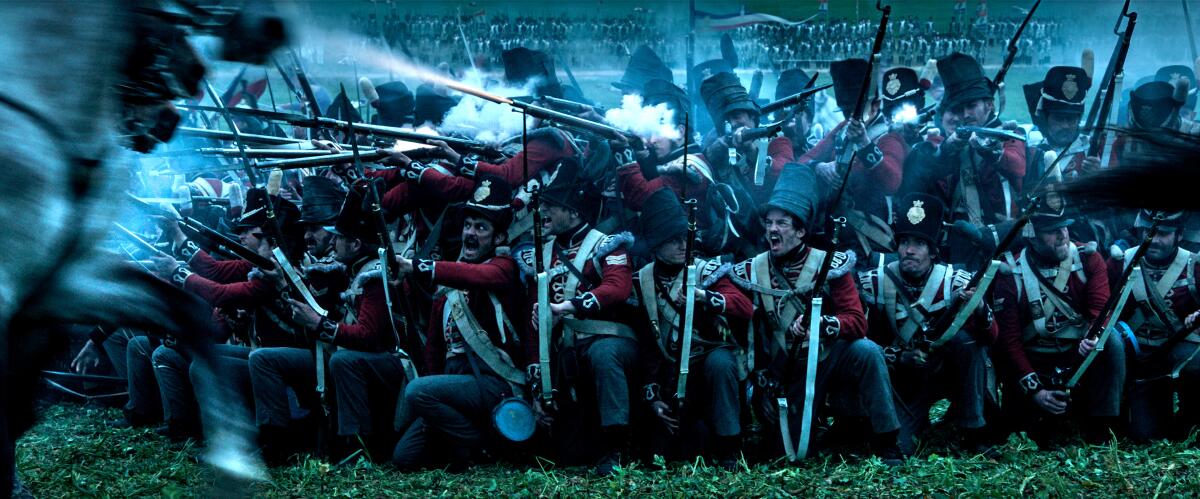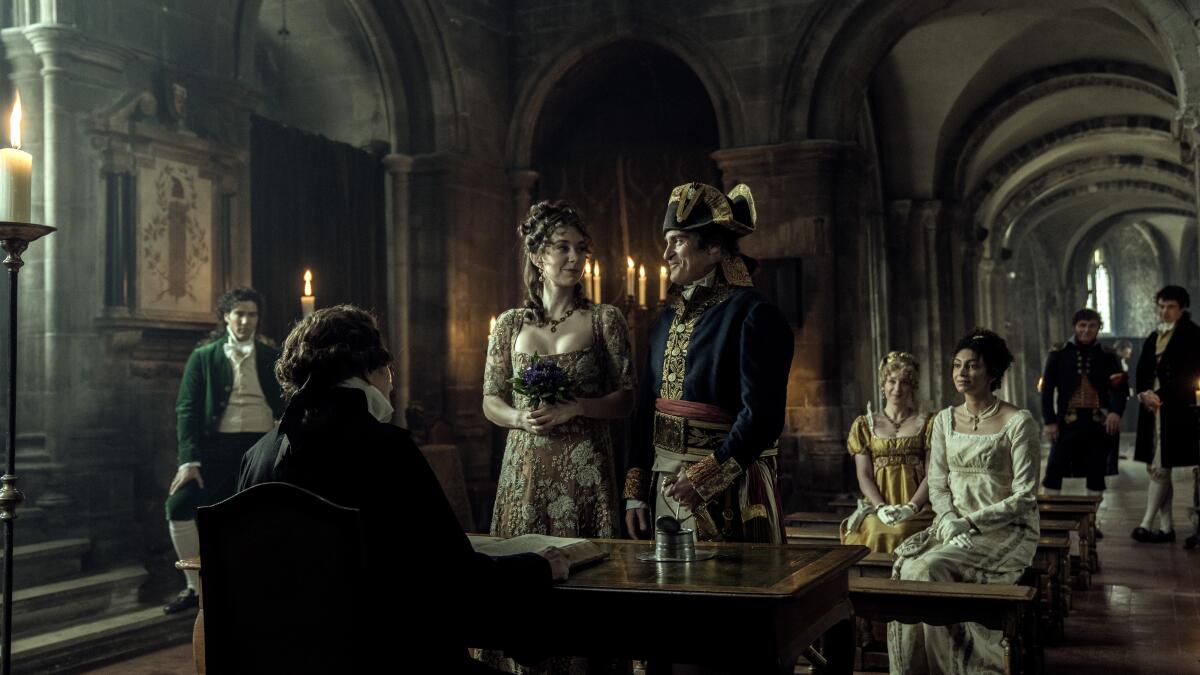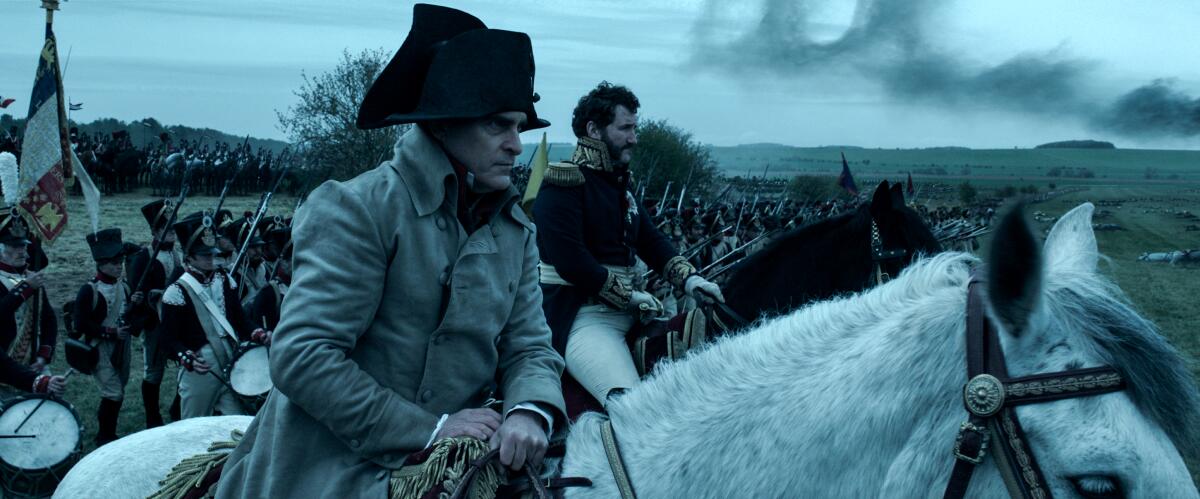Sign up for The Envelope
Get exclusive awards season news, in-depth interviews and columnist Glenn Whipp’s must-read analysis straight to your inbox.
You may occasionally receive promotional content from the Los Angeles Times.

It takes an army to dress an army. The costume design team behind “Napoleon,” the epic retelling of Napoleon Bonaparte’s personal life and military career, had to think like the legendary French general by constantly strategizing, relentlessly researching and exhaustively applying all of their skills.
Director Ridley Scott returned to his frequent collaborator, costume designer Janty Yates, who won an Oscar for her work on Scott’s “Gladiator.” She turned to her own collaborator, David Crossman, a military costume design expert who focused on Napoleon and the many armies.
Together they made thousands of uniforms, hundreds of civilian outfits and dozens of elegant ensembles for royalty and aristocrats.
At a time when there’s greater sensitivity around elevating stories about women, the director has long focused on intelligent, nuanced female characters.
“You wake up at 3 in the morning absolutely terrified, because you are so worried about it getting done. Plus, you want it to look lovely, because it is Napoleon,” said Crossman, who created more than 4,000 uniforms and helped create an elaborate coronation scene.
The Apple Original Films and Columbia Pictures production is a military action movie crossed with a love story that stars Oscar winner Joaquin Phoenix as Napoleon and Vanessa Kirby as Empress Josephine. It’s a lush retelling that absorbs the elegance of the Napoleonic era, which is well documented in art.
“You want it to look something like those paintings, because all of the paintings of the period are beautiful. You want it to look like that and not a terrible costume movie,” Crossman said. Though Scott, who has four Oscar nominations, didn’t specifically request exacting historical accuracy in the costumes, that’s what he got.

“We did a huge amount of hands-on research,” said Yates. She and Crossman visited museums and historical sites such as the enormous royal retreat south of Paris, the Château de Fontainebleau; the Musee de L’Emperi, which contains large stores of French military uniforms; the British Museum; the Victoria and Albert Museum; and Château de Malmaison, which is where Josephine retired and died in 1814.
The team studied actual garments that Napoleon and his wife, Josephine, wore in the 1800s, plus other rare period clothes, including his famous bicorn hat. Yates said that especially for Josephine’s 30 richly embellished gowns, everything visible was hand-sewn, adding to the verisimilitude.
“We were able to borrow lots of absolutely original French Revolution coats and breeches, which we then took patterns from and made copies of. We used that for mass production,” Crossman said. That authentic silhouette would erase the creep of modernization that taints many rental costumes. Plus, no costume house had near the quantity of period uniforms they required for the many battles.
Yet some historic processes had to bend to contemporary concerns.

“One of the things I was most worried about was producing his hat, because [Phoenix] can’t wear felt. It’s a wool item,” Crossman said, citing the actor’s aversion to anything made of animal products. “If the hat were a synthetic, it would look terrible. Then we came across a processed tree bark, which looks very much like felt and has an interesting texture.” It worked. Still, sheer numbers were their ongoing challenge.
The duo costumed up to 900 background actors daily for large scenes (Yates recalled dressing up to 3,000 extras a day for “Gladiator”). Most days, however, required dressing between 300 and 400 background actors, which could include crowd scenes, or multiple army units from different countries. Though computer-generated imagery could fill in some scenes, “It was still a helluva lot,” Yates said.
The film was shot on location mostly in England and on the remote island of Malta. A costume crew headquartered in a large London warehouse staged the costumes for each day’s shoot. That effort required a costume department crew of about 80, plus untold numbers of artisans in workshops around the world who wove custom fabric, cast jewelry and hand-embroidered costumes with bullion wire.

The nonstop, nearly five-month shoot required the costume team to fit each background actor with four to six costumes to build efficiency into the scene changes.
One of the most daunting scenes was the massive coronation, which took place at Notre Dame in 1804 and is depicted in “The Coronation of Napoleon,” the 1807 painting by Jacques-Louis David. “He sums up the whole Napoleonic Empire in his art,” Yates said.
“The scene was quite huge because we completely copied, literally dress by dress, the David painting,” she said. “I think our trains that we had for Joaquin and Vanessa as Josephine and Napoleon are exactly the same length and the exact same embroidery.”
Some of that embroidery contributed to Crossman’s sleepless nights. Many of the military and coronation costumes were so elaborately decorated that they needed months of hand work. Crossman and Yates had to send pattern pieces to be embroidered months ahead of shooting and casting, meaning they had to account for changes in final sizes.
Through years of studying historical photos, home movies, museum collections and archives, the filmmaking team actually helped to revive parts of the Osage culture, including the making of authentic clothing.
Their exhaustive research also busted a myth about Napoleon’s size.
“Everybody was under the impression that he was very short. He wasn’t,” Yates said. “That was British propaganda.”
And that other classic bit with the general slipping his hand inside his jacket? Though Napoleon was portrayed with that stance, the gesture didn’t end up in the movie.
“I asked Joaquin if he was going to do it,” Crossman said. The response: “Nah.”
Sign up for The Envelope
Get exclusive awards season news, in-depth interviews and columnist Glenn Whipp’s must-read analysis straight to your inbox.
You may occasionally receive promotional content from the Los Angeles Times.